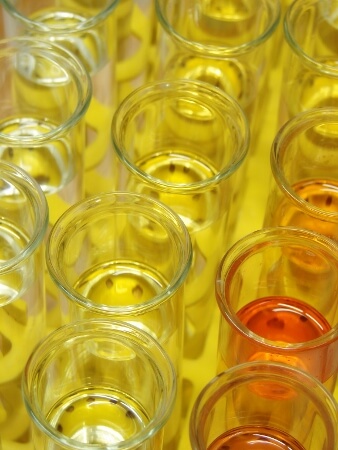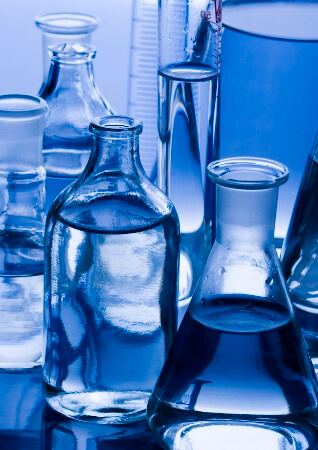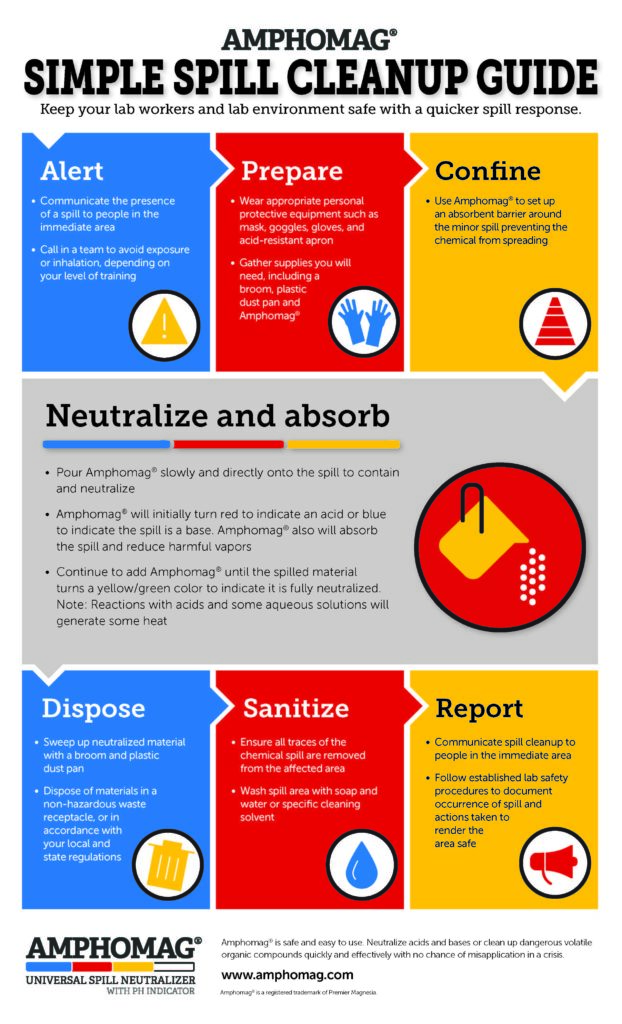Amphomag® Universal Spill Neutralizer – The Answer for All Spill Types
Amphomag treats all kinds of spills. Acids, bases, organics, hydrocarbons, water reactive liquids, air reactive liquids, oxidizers, and reducing agents like hydrazine. Amphomag is an amphoteric buffer, so you don’t have to worry about overdosing. Excess neutralization creates no hazard since Amphomag is not a controlled material for sanitary waste landfills.
Amphomag has been tested for vapor suppression and is unsurpassed for acidic vapors. It is comparable to activated carbon for organic hydrocarbon vapors. There is no additional BTU value as the result of using Amphomag and it will not support combustion. Common organics like paint related materials will easily pass the paint filter test so that landfilling becomes an option.
How Much Amphomag Is Needed?
When applying Amphomag to accidental spills use a heavy broadcast method. It may also be used as a diking material for containment. Reactions with acids and some aqueous solutions will generate some heat. Reaction with bases creates little or no heat. Amphomag is highly effective at containing liquid spills, and preventing them from potentially entering the environment.
The amount of Amphomag needed to contain an aqueous spill is about the weight of the spill. In order to completely neutralize the spill material, the amount of Amphomag required will depend on the concentration of the spilled substance.
What is the Resultant Material?
When neutralizing, Amphomag brings the pH of a spilled material into a safe range. After neutralization, the product formed will be a magnesium salt and a mixture of other related compounds depending on the material neutralized.
When containing, Amphomag is suppressing vapor release. The result is a contained, adsorbed spill that would still be listed by the Resource Conservation Recovery Act (RCRA) as hazardous. Organic materials are contained in a non-combustible inorganic matrix suitable for long term storage of hazardous materials.

ACIDS
All acids will generate heat when neutralized with Amphomag. In order to reduce the potential for splattering, apply a large excess of Amphomag and completely cover spill with a thick layer of Amphomag. When Amphmag is applied to the acid spill, the pH indicator should turn red. This indicates that the spill is still acidic and more Amphomag needs to be applied until a yellow/green color indicates neutralization is complete.
- Acetic
- Acrylic
- Boric
- Citric
- Formic
- Glycolic
- Hydrochloric
- Hydrofluoric
- Hypochlorous
- Nitric
- Oxallic
- Perchloric
- Phosphoric
- Sulfuric
- Sulfurous
- Arsenic
- Chromic
- Hydrocyannic

Bases
Neutralization of alkalis with Amphomag will generate little heat. It is unlikely any splattering will occur. When Amphomag is applied to the alkali the pH indicator should turn blue. This indicates that the spill is still alkaline and more Amphomag should be applied until a yellow/green color indicates that neutralization is complete.
- Ammonium Hydroxide
- Potassium Hydroxide
- Sodium Hydroxide
- Aniline
- Calcium Hypoclorite (solution)
- Ethanolamine
- Hydrazine
- Methylamine
- Sodium Cyanide (solution, poison)
- Sodium Hypochlorite (solution, oxidizer)

SOLVENTS & OTHER LIQUIDS
Amphomag acts as a sorbent in the case of these liquids and will not render the spill nonhazardous. No adverse reactions with organic solvents are known. If the organic solvent contains appreciable amounts of water, then some heat can be generated. Apply Amphomag until the spill is dry. Since organic solvents are generally not acidic nor alkaline, the pH indicator is non-functional under these circumstances.
Organic (flammable)
- Paint Related Material
- Fuels
- Ketones
- Ethers
- Solvents
- Alcohols
Poison
- Cyanides
- Insecticides
- Pesticides
- Herbicides
Mixtures
- Biohazards
- Radioactive
- Metal Slurries
Oxidizers
- Peroxides
Water Reactive
- Metals
- Organics
- Salts
- Poisons
CFCs and CHCs
- Chloroform
- Freon
- PCBs
- TCBs
- 1, 1, 1 Trichloroethane
- Trichloethylene

GASSES
Amphomag has been tested for vapor suppression and is unsurpassed for acidic vapors. It is comparable to activated carbon for organic hydrocarbon vapors. There is no additional BTU value as the result of using Amphomag and it will not support combustion.
- Ammonia
- Chlorine
- Hydrogen Chloride
- Sulfur Dioxide
For more information related to specific experience relevant to your application, please contact us.




